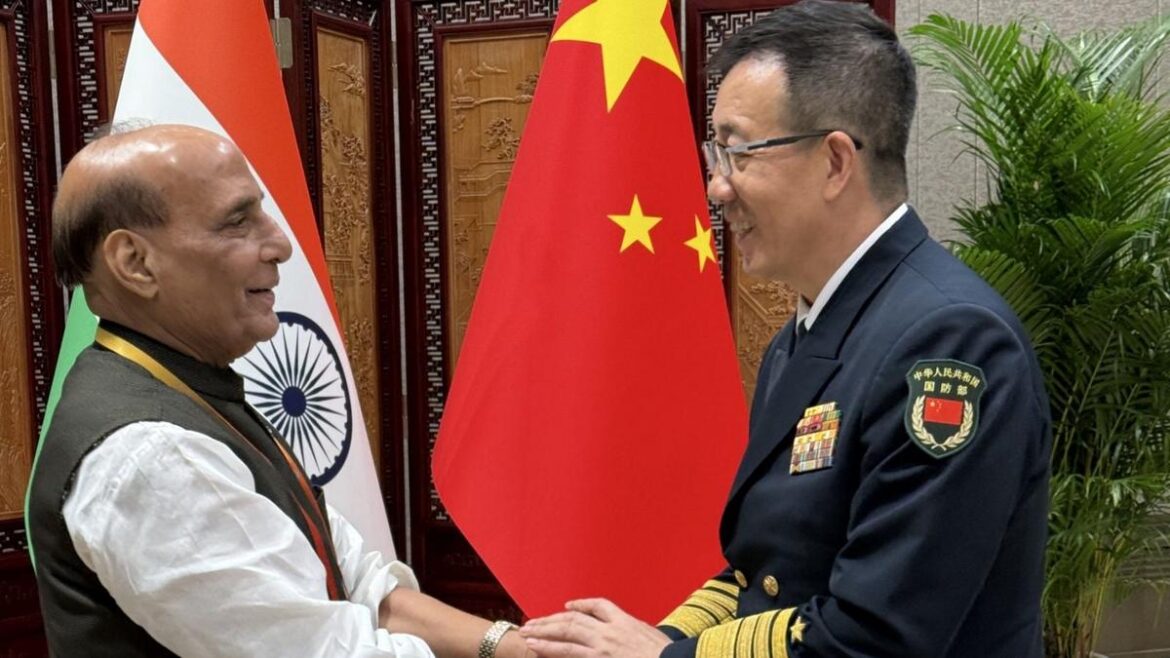India Calls for Long-Term Peace Framework with China on Border Disputes
During a high-stakes meeting in New Delhi, Indian Defence Minister Rajnath Singh emphasized the importance of a structured, ongoing dialogue with China to resolve ongoing border tensions that have flared intermittently since 2020. He urged his Chinese counterpart, Defence Minister General Li Shangfu, to engage in a “permanent and comprehensive” system of de-escalation to prevent further conflicts.
Face-Offs Along the Line of Actual Control
India and China haven’t seen eye-to-eye along the Line of Actual Control (LAC), particularly in areas like Ladakh, where soldiers from both sides have clashed in recent years. While agreements have been reached and some disengagement has taken place, sporadic tensions continue to disrupt fragile stability.
“India wants to work with China to normalize ties, but this requires restoring peace and tranquility along the border areas,” Singh said to General Li during their meeting on the sidelines of the Shanghai Cooperation Organisation (SCO) Defence Ministers’ gathering.
Why the Meeting Matters Now
This conversation took place at a time when diplomatic relations remain tense and delicate. Since the deadly Galwan Valley skirmish in June 2020, where 20 Indian soldiers and at least four Chinese troops lost their lives, high-level military and diplomatic talks have become routine—but little breakthrough has been achieved beyond phased disengagement in limited zones.
Even with 18 rounds of corps commander-level meetings behind them, both sides continue to maintain significant troop presences near friction points like Depsang and Demchok. India has been clear: normalization of broader bilateral ties cannot proceed without resolving border disputes.
India Pitches a Permanent Dialogue Mechanism
What Singh seems to be proposing is not another temporary fix, but instead a:
- Structured roadmap of talks
- On-ground efforts to reduce direct encounters between troops
- Mutual respect for previously signed border agreements
“Violations of existing agreements have eroded trust,” said a senior defence official familiar with the talks. Singh reportedly told Li that any repeat of 2020-like situations would not be acceptable, and both sides must work to prevent such “complexities.”
China Stays Guarded in Its Response
While there’s limited information on how General Li responded to Singh’s pointed demands, China has traditionally pushed for keeping broader bilateral ties separate from the border standoff. In past statements, the Chinese foreign ministry has framed the border situation as “manageable.”
Yet, India remains unconvinced by such classifications. Officials here argue that peace on the ground is fundamental to any progress in trade, investment, student exchanges, or regional cooperation. “What’s the point of partnerships in New Delhi or Beijing if patrols are squaring off at 14,000 feet in Ladakh?” one Indian strategist quipped off the record.
De-Escalation: Still a Long Road Ahead
The path to resolution is unclear. While disengagement has taken place in four key areas—including Pangong Tso, Galwan, Gogra and Hot Springs—issues in Depsang and Demchok remain unresolved. This reluctance to pull back from all friction zones raises doubt over China’s long-term intentions.
Officials say talks continue, but progress is slow and incremental. Several Indian defense analysts argue that without political will on both sides, even the best military-to-military channels may hit a wall.
“You can’t expect the soldiers on the ground to solve what is essentially a political problem,” said Manoj Joshi, a senior fellow at the Observer Research Foundation in Delhi.
Pressure to Maintain Troop Readiness
India has had to ramp up infrastructure and troop presence on its side of the LAC. New roads, quicker deployment systems, and high-altitude logistics have all been put in place. But this has come with costs—both fiscal and diplomatic.
If a broader framework isn’t put in place soon, the status quo may become permanent. Military standoffs aren’t new between these nations, but the duration and intensity of post-2020 deployments are unprecedented since the 1962 war.
Public Sentiment Leans Toward Caution
Within India, public opinion remains wary of rushing into talks without clear Chinese commitment. National security debates frequently underline the unpredictability of the Chinese political-military axis. Some fear Beijing might use dialogue as a stalling tactic while reinforcing territorial claims.
Still, Singh’s tone was measured but firm. “Both parties need to show sensitivity and willingness to resolve issues. We’re ready to talk, but you have to walk, too,” he reportedly said.
What Comes Next? Watch the Diplomatic Calendar
Internationally, India’s balancing act between the West and regional powers like China—and Russia, another SCO member—is under closer scrutiny. The next few months will reveal whether the message delivered in New Delhi carried any real weight back in Beijing.
With the G20 summit approaching and India in a leading global role, the government may face pressure, both external and internal, to show results—not just statements. Skepticism runs high, but hope for a breakthrough hasn’t entirely faded yet.
Key Takeaways
- India insists on a comprehensive peace roadmap with China to prevent border flare-ups.
- Defence Minister Singh warned against creating “new complexities” in border zones.
- Disengagement is still incomplete in key Ladakh areas, undermining progress.
- China’s official stance remains vague, focusing on managing—not resolving—disputes.
- India’s future engagement with China could hinge on genuine border de-escalation steps.
This story is still unfolding—and whether it moves toward resolution or more stand-offs depends greatly on what conversations follow this latest encounter.

